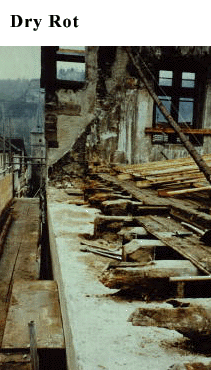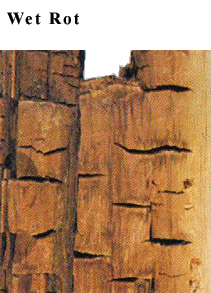|
Fungi are plants which depend on other
plants for their food. They are parasites. Fungi do not contain
the chlorophyll, which enables higher plant life to make food
in sunlight from carbon-dioxide in the air and water in the soil.
A fungus requires 4 conditions to grow:
(1) food in the form of wood cells
(2) not less than 20% moisture content (M.C.)
(3) oxygen, from the air
(4) a suitably warm temperature.
Fungi are most readily identified as mushrooms
which are the fruit body' growing out of the timber. The fruit
body produces tiny 'spores which are blown by wind and carried
to other wood where they will germinate if conditions are right.
After germinating the fungus starts to produce cells called 'hyphae'
which feed on the wood in order to grow itself. The hyphae spread
out through the wood in a web-like manner to form what is called
a 'mycelium'. From this mycelium will appear the mushroom
or fruit body which produces the spores in order to continue
the life-cycle of the fungus. All types of fungi live on the
starches and sugars in the timber. Wood-rotting fungi attack
the cell walls of the wood. Sap-staining fungi feed only on the
contents of the sapwood.
Wood-rotting fungi

Merulius Lacrymans
is commonly known as 'Dry Rot'. Merulius Lacrymans thrives in
damp, unventilated situations. As it develops it chars the wood,
turning it dark-brown and drying it out (therefore it is referred
to as (dry-rot). Dry-rot causes serious damage to timber and
can only be dealt with by cutting out the affected and surrounding
area and burning.
- It is a malignant growth
- It requires moisture content as little as
20%.
- The vast majority of the infection is often
concealed
- It is very often associated with poor ventilation
- It often attacks timbers that are some distance
from the original source of dampness

Coniophora Puteana
is commonly known as 'Wet Rot' as it is requires very wet conditions
(moisture content greater than 30%) to develop. It chars the
timber. The fungus can be stopped by simply drying out the affected
and surrounding area.
- It only degrades wet timber that has a moisture
content of 30-50%
- It is normally associated with free running
water
- It is most commonly found in joist ends,
skirting boards and external joinery
Recognition of Decay
There are 4 points to watch out for when trying to detect the
presence of a flingus in the early stages of attack.
(1) A change of colour; the wood deepens in colour
(2) The wood becomes softer
(3) There is a loss in weight
(4) There can be a musty smell
Eradication of
Decay
(1) Have the fungus identified
(2) Locate the source of the infection and prevent any further
entry of moisture
(3) Remove all infected timber and burn immediately
(4) If the fungus is a dry-rot then any brickwork and walls close
to the infected timber must be sterilized as dry-rot fungi will
invade brickwork and mortar seeking moisture. The replacement
timber aswell as the surrounding timbers must be treated with
a preservative.
(5) If the fungus is a wet-rot the surrounding walls or brickwork
not need be sterilized. Only the replacement and surrounding
timbers need to be treated with a preservative.
Prevention of Decay
(I) Use naturally durable timbers
(2) Keep all timber dry, at or below 20% moisture content
(3) Make sure there is good ventilation
(4) Treat non-durable timber with a preservative if it cannot
be kept dry
Sap-Staining Fungi
Sap-staining fungi do not attack the cell walls of the wood,
only the contents of the wood cells, and so will not decay the
timber. The fungus causes a bluish stain in the wood which may
make the wood useless for furniture making or veneering for instance.
The fungus will thrive in freshly cut timber or unseasoned timber
that has not been properly stacked, for instance without stickers.
Sap-stain will not occur in correctly seasoned timber. It can
be treated with a preservative that will prevent further attack
and kill the existing fungus. |